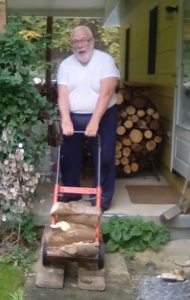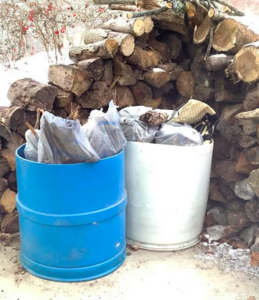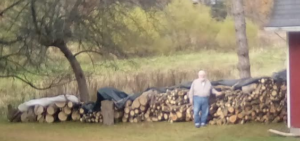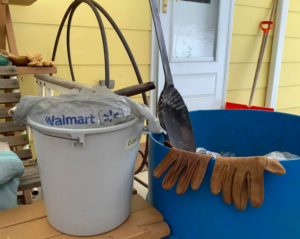A fun idea by
Larry Pearce
12/16/23
Oh, if our ancestors only had plastic shopping bags from their local Walmart and Giant Eagle? I’d been thinking about them and their wood piles as I worked this afternoon. It’s mid-December and I just finished bagging up the bark in the barrels on the back porch. How’s that for alliteration? I always knew my two graduate degrees in English Communication would come in handy after I retired from teaching! My wife must get tired of me suggesting with ambitious pride that I patent my brilliant idea to put the dust, clippings, and shavings from our firewood manufacturing to good use, not wasting a chip. In the end I guess I’m happy just to gain a few more BTUs for the house, denying the electric company even more monthly kilowatt charges during the winter months. We’ve been heating the house with wood for nearly half a century on our 18-acre estate. Not a dead tree or falling limb has had a chance to decompose, and while some of our neighbors “go to the gym” to stay fit, I spend most of the months cutting, hauling, splitting, and stacking nature’s carbon products near the back porch. We even have a doorway for our kitties to come and go on either end.
Of course they love to climb to the top of each pile and stay on top of the wildlife beyond. Someone once said that “firewood burns twice: once when you make that fire and at each step as you prepare it for the burn.” To me, processing dead trees adds up to more than twice. Maybe the best part is that the whole preparation process gets me out of the house. I hear some of you saying that I shouldn’t be polluting the air by creating greenhouse gases. My response is that one, there’s plenty of those gases created when my electric company burns coal or natural gas to generate power for my all-electric home, and two, I’m just speeding up the whole natural decomposition process all that dead firewood is prone to around the farm. It’s like putting cow manure on the fields to fertilize the food I eat; better than the farting those creatures do, escaping any practical use. Besides, I do create piles of smaller, unburnable limbs for my rabbits and foxes to nest. I could shred those leftovers and burn them too, but I choose not to.
Anyway, this is a description of the manner in which I handle the smaller residuals of my firewood manufacturing: the bark and saw dust. Periodically, after the logs are hauled to the preparation area and sawed, I rake the residue with a grass rake onto a snow shovel and dump it into an open, plastic 55-gallon drum. Once the cutting, splitting, hauling, and stacking is complete, I give the area one final sweep and dump. The barrels are then taken to my barn for storage out of the weather until they are moved to my back porch for the winter burning season. The loose contents of the barrels are allowed to dry. The containers are lighter than one would think and can be moved by rolling through the grass on their bottom edges, hand-carted, or even slid across the cement side of the barn. I usually work close to my barn because the ground is more level there. Once the final hauling and stacking of short logs onto the back porch of the house is underway, I back the ATV with cart into the barn to pick up the barrels. They are light enough to lift, or may be slid up a short, wooden ramp. That cart then is backed into the edge of the porch for removal of the barrels. Now the fun begins, the part I want to patent (in my dreams). Once all the logs are stacked on the perimeter of the porch, and the barrels are parked under the roof, I move a picnic bench and a folding chair next to a barrel. I take a 1-gallon plastic bucket, set it on the bench next to the barrel, and insert a plastic grocery bag inside. My bucket has spouts on either end of the top, over which the handles of the bag can be looped. The open end of the bag fits perfectly around the top of the bucket to hold it in place. Now I find my small, flat, metal scoop, which I use to remove ashes from the wood stove, and what I call a short-handled “scratcher,” used to cultivate the flower beds.
Once the final hauling and stacking of short logs onto the back porch of the house is underway, I back the ATV with cart into the barn to pick up the barrels. They are light enough to lift, or may be slid up a short, wooden ramp. That cart then is backed into the edge of the porch for removal of the barrels. Now the fun begins, the part I want to patent (in my dreams). Once all the logs are stacked on the perimeter of the porch, and the barrels are parked under the roof, I move a picnic bench and a folding chair next to a barrel. I take a 1-gallon plastic bucket, set it on the bench next to the barrel, and insert a plastic grocery bag inside. My bucket has spouts on either end of the top, over which the handles of the bag can be looped. The open end of the bag fits perfectly around the top of the bucket to hold it in place. Now I find my small, flat, metal scoop, which I use to remove ashes from the wood stove, and what I call a short-handled “scratcher,” used to cultivate the flower beds.
Sitting on the patio chair for comfort, I simply scratch the bark onto the shovel and dump it into the bucket. One may use a hand to move the bark onto the shovel, but then gloves are recommended to save the skin and avoid any poison plants that may have come along for the ride. It’s best to fill the bucket even to the top. The bag handles are then taken off the spouts and tied together tightly atop the bark bag. I can stack each bag in a wood pile corner of the porch, but it’s best to place them in an empty barrel and cover them with the barrel top or plastic to keep any blowing rain or snow out. You can slide the full barrel on the cement right up to the back door.
Another “tip” when filling the bags: As the barrels are scooped down, and the bark is harder to get to, I lift and tilt the barrels on that same bench, propping them against something behind. There’ll come a point when the barrel is light enough to pour the remaining contents into a 5-gallon bucket and then into the bag-in-the bucket.
Finally, there are always longer pieces of bark or sometimes shavings to contend with. By this time they are dry enough to break apart and fit into the bag. For the contentious long ones, I place them on end in the metal bucket in which I haul logs into the house. They can be used as kindling for starting or “goosing-up” fires.
When the time comes to take the bags into the house for burning, I place them in a 5-gallon plastic bucket, which will hold two bags nicely. I try to place that bucket a safe distance from the wood stove to warm-up before burning. My burner holds two bags for quick heating, but I also use just one to get logs going in the morning. A word of caution here: if there are hot coals in the stove, open the door fully and plan to insert the bag quickly, pushing it completely to the back of the hot stove. There’s no “halfway hesitation” or the thin plastic can melt, spilling the potentially burning chips back out the front and onto the floor. It’s best to close the door immediately for safe keeping, and whatever you do, don’t allow a melting bag to touch your skin. Running cold water over a burn is the only relief I know. But, if there are no hot coals, scrap paper is enough to get the bark burning.
Some will say that not only I shouldn’t be burning wood, but that burning plastic is even worse. Several responses: first, few of these tiny, thin bags would be recycled. My wife and I do return some to the stores and to the Meals on Wheels for which we volunteer each week. But, unfortunately, so many are placed in the trash and end up in the local landfill where they remain for centuries. Ours are not wasted and serve as a practical safety factor in the heating with wood process. They keep the accumulated carbon dry and clumped together as it enters the burning chamber. I burn the chips infrequently, usually to ignite accompanying logs and to get quick heat after a cold night. It will be interesting to see how long my four barrels of bark-in-bags will last this winter season. With global warming recently, I haven’t needed to burn as many logs, and the heating season, usually November through March, is shorter than it used to be.
I hope I didn’t miss anything. You will probably improve on my method – then you too can patent your product! Meanwhile, Happy Heating.
Last revised 1/14/24





